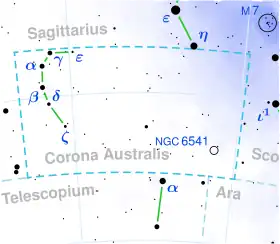 | |
| Observation data Epoch J2000.0 Equinox J2000.0 (ICRS) | |
|---|---|
| Constellation | Corona Australis |
| Right ascension | 19h 14m 39.56095s[1] |
| Declination | −45° 11′ 36.6990″[1] |
| Apparent magnitude (V) | 5.91±0.01[2] |
| Characteristics | |
| Spectral type | G8 III[3] |
| B−V color index | +0.90[4] |
| Astrometry | |
| Radial velocity (Rv) | −35.1±0.4[5] km/s |
| Proper motion (μ) | RA: +47.604[1] mas/yr Dec.: −39.804[1] mas/yr |
| Parallax (π) | 9.9058 ± 0.0428 mas[1] |
| Distance | 329 ± 1 ly (101.0 ± 0.4 pc) |
| Absolute magnitude (MV) | +1.11[6] |
| Details[7] | |
| Mass | 2.45±0.04 M☉ |
| Radius | 8.26±0.14 R☉ |
| Luminosity | 43.3±1.0 L☉ |
| Surface gravity (log g) | 2.88±0.07 cgs |
| Temperature | 5,120±30 K |
| Metallicity [Fe/H] | −0.004±0.027 dex |
| Rotational velocity (v sin i) | 2.9±1[8] km/s |
| Age | 727±10[9] Myr |
| Other designations | |
| Database references | |
| SIMBAD | data |
HD 179433, also known as HR 7281 or rarely 49 G. Coronae Australis, is a solitary star located in the southern constellation Corona Australis. It is faintly visible to the naked eye as a yellow-hued point of light with an apparent magnitude of 5.91.[2] Gaia DR3 parallax measurements imply a distance of 329 light-years,[1] and it is currently drifting closer with a heliocentric radial velocity of −35.1 km/s.[5] At its current distance, HD 179433's brightness is diminished by interstellar extinction of 0.22 magnitudes[12] and it has an absolute magnitude of +1.11.[6]
HD 179433 has a stellar classification of G8 III,[3] indicating that it is an evolved red giant. It has 2.45 times the mass of the Sun[7] but at the age of 727 million years,[9] it has expanded to 8.26 times the Sun's radius.[7] It radiates 43.3 times the luminosity of the Sun from its enlarged photosphere at an effective temperature of 5,120 K.[7] HD 197433 has a near solar metallicity at [Fe/H]= −0.0004[7] and it spins modestly with a projected rotational velocity of 2.9 km/s.[8]
References
- 1 2 3 4 5 6 Vallenari, A.; et al. (Gaia collaboration) (2023). "Gaia Data Release 3. Summary of the content and survey properties". Astronomy and Astrophysics. 674: A1. arXiv:2208.00211. Bibcode:2023A&A...674A...1G. doi:10.1051/0004-6361/202243940. S2CID 244398875. Gaia DR3 record for this source at VizieR.
- 1 2 Høg, E.; Fabricius, C.; Makarov, V. V.; Urban, S.; Corbin, T.; Wycoff, G.; Bastian, U.; Schwekendiek, P.; Wicenec, A. (March 2000). "The Tycho-2 catalogue of the 2.5 million brightest stars". Astronomy and Astrophysics. 355: L27–L30. Bibcode:2000A&A...355L..27H. ISSN 0004-6361. S2CID 17128864.
- 1 2 Houk, Nancy (1978). Michigan catalogue of two-dimensional spectral types for the HD stars: Declinations −53° to −40°. Vol. 2. Bibcode:1978mcts.book.....H.
- ↑ Corben, P. M. (April 1971). "Photoelectric Magnitudes and Colours for Bright Southern Stars". Monthly Notes of the Astronomical Society of South Africa. 30 (4): 37. Bibcode:1971MNSSA..30...37C. ISSN 0024-8266.
- 1 2 Gontcharov, G. A. (November 2006). "Pulkovo Compilation of Radial Velocities for 35,495 Hipparcos stars in a common system". Astronomy Letters. 32 (11): 759–771. arXiv:1606.08053. Bibcode:2006AstL...32..759G. doi:10.1134/S1063773706110065. eISSN 1562-6873. ISSN 1063-7737. S2CID 119231169.
- 1 2 Anderson, E.; Francis, Ch. (May 2012). "XHIP: An extended hipparcos compilation". Astronomy Letters. 38 (5): 331–346. arXiv:1108.4971. Bibcode:2012AstL...38..331A. doi:10.1134/S1063773712050015. eISSN 1562-6873. ISSN 1063-7737. S2CID 119257644.
- 1 2 3 4 5 Ottoni, G.; Udry, S.; Ségransan, D.; Buldgen, G.; Lovis, C.; Eggenberger, P.; Pezzotti, C.; Adibekyan, V.; Marmier, M.; Mayor, M.; Santos, N. C.; Sousa, S. G.; Lagarde, N.; Charbonnel, C. (January 2022). "CORALIE radial-velocity search for companions around evolved stars (CASCADES): I. Sample definition and first results: Three new planets orbiting giant stars". Astronomy & Astrophysics. 657: A87. arXiv:2201.01528. Bibcode:2022A&A...657A..87O. doi:10.1051/0004-6361/202040078. eISSN 1432-0746. ISSN 0004-6361. S2CID 245440163.
- 1 2 De Medeiros, J. R.; Alves, S.; Udry, S.; Andersen, J.; Nordström, B.; Mayor, M. (January 2014). "A catalog of rotational and radial velocities for evolved stars V: Southern stars *". Astronomy & Astrophysics. 561: A126. arXiv:1312.3474. Bibcode:2014A&A...561A.126D. doi:10.1051/0004-6361/201220762. eISSN 1432-0746. ISSN 0004-6361. S2CID 54046583.
- 1 2 Gomes da Silva, J.; Santos, N. C.; Adibekyan, V.; Sousa, S. G.; Campante, T. L.; Figueira, P.; Bossini, D.; Delgado-Mena, E.; Monteiro, M. J. P. F. G.; de Laverny, P.; Recio-Blanco, A.; Lovis, C. (February 2021). "Stellar chromospheric activity of 1674 FGK stars from the AMBRE-HARPS sample. I. A catalogue of homogeneous chromospheric activity". Astronomy & Astrophysics. 646: A77. arXiv:2012.10199. Bibcode:2021A&A...646A..77G. doi:10.1051/0004-6361/202039765. eISSN 1432-0746. ISSN 0004-6361. S2CID 229331727.
- ↑ Gould, Benjamin Apthorp (1878). "Uranometria Argentina : brillantez y posicion de las estrellas fijas, hasta la septima magnitud, comprendidas dentro de cien grados del polo austral : con atlas". Resultados del Observatorio Nacional Argentino. 1. Bibcode:1879RNAO....1.....G.
- ↑ "HD 179433". SIMBAD. Centre de données astronomiques de Strasbourg. Retrieved June 4, 2023.
- ↑ Gontcharov, George A.; Mosenkov, Aleksandr V. (28 September 2017). "Verifying reddening and extinction for Gaia DR1 TGAS main sequence stars". Monthly Notices of the Royal Astronomical Society. 472 (4): 3805–3820. arXiv:1709.01160. Bibcode:2017MNRAS.472.3805G. doi:10.1093/mnras/stx2219. eISSN 1365-2966. ISSN 0035-8711. S2CID 118879856.